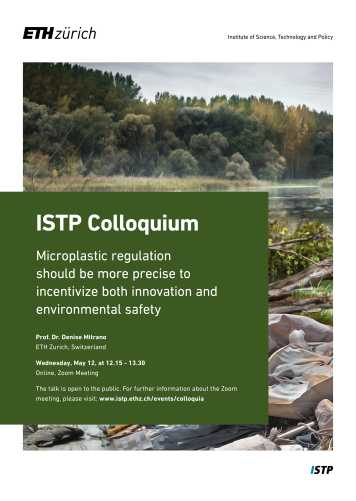Colloquium: Prof. Denise Mitrano
Wednesday, May 12, 2021, at 12.15 - 13.30
Online, Zoom | Sign up here
Microplastic regulation should be more precise to incentivize both innovation and environmental safety

Numerous studies have made the ubiquitous presence of plastic in the environment undeniable, and thus it no longer comes as a surprise when scientists monitor the accumulation of macroplastic litter and microplastic fragments in both urban and remote sites. The presence of plastic in the environment has sparked considerable discussion amongst scientists, regulators and the general public as to how industrialization and consumerism is shaping our world. Restrictions on the intentional use of primary microplastics, small solid polymer particles in applications ranging from agriculture to cosmetics, are under discussion globally, despite uncertain microplastic hazards and prioritization amongst options for action. In some instances, replacements are technically simple and easily justified, but in others substitutions may come with more uncertainty such as significant performance questions and monetary costs. Scientific impact assessment of primary microplastics compared to their alternatives relies on a number of factors including, but not limited to, microplastic harm, existence of replacement materials, and the quality, cost and hazards of alternate materials. Here we assess the scope, effectiveness and utility of microplastic regulations with specific emphasis on the new definitions proposed by ECHA for restriction of primary microplastics under REACH.
To this end, we aim to 1) provide a systematic orientation of the polymer universe, to appreciate which (micro)plastic characteristics are relevant, measurable and enforceable, 2) cluster specific uses of solid plastic to highlight how primary microplastic can add to issues of environmental pollution and human health, 3) evaluate drivers leading to regulations and their potential for enforceability and impact and 4) suggest priority cases where regulations should be focused and precision increased to incentivize innovation of sustainable materials and promote environmental health and safety. Regulations need a precise focus and must be enforceable by measurements. Policy must carefully evaluate under which contexts microplastic use may be warranted and where incentives to replace certain microplastics can stimulate innovation of new, more competitive and environmentally conscious materials.
About Prof. Denise Mitrano
As an environmental analytical chemist with training in geochemistry, my research focuses on the distribution and impacts of anthropogenic materials in technical and environmental systems. I am particularly interested in developing analytical tools to systematically understand the mechanisms and processes driving the fate, transport and biological interactions of particles, such as natural colloids, engineered nanomaterials and nano- and microplastics. In this context, my research group uses these results to assess risks of anthropogenic materials. An interest in a “safer by design” approach for both nanomaterials and plastics is exemplified by working on the boundaries of environmental science, materials science and policy to promote sustainability and environmental health and safety of new materials.
You can read a Summary of the Colloquium Talk on our Reports page.
You can also download the presentation of the talk protected page here (accessible only by ETH members).